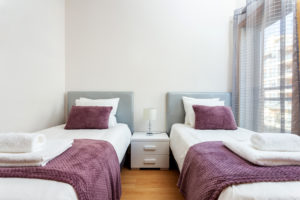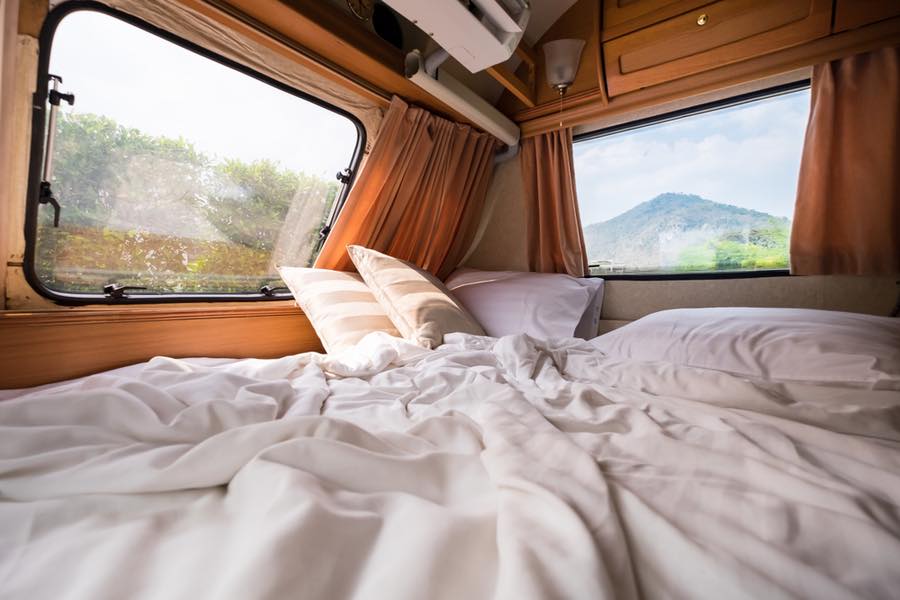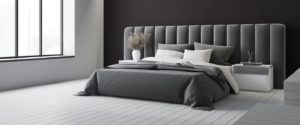When you buy through our links, we may earn a commission. Products or services may be offered by an affiliated entity. Learn more.
What Size Is a Crib Mattress?
- Most crib mattresses share the same standard dimensions of 28 inches wide by 52 inches long, so that they adhere to Consumer Product Safety Commission guidelines.
- In addition to standard crib mattress sizes, you can also choose from other options such as mini crib mattresses and specialty designs.
- To keep your baby safe, make sure the crib mattress fits snugly without any gaps between the mattress and frame.
If there’s one thing babies do a lot, it’s sleep. Having a safe place to put them down is one of the most important must-haves on your baby shopping list. And there’s no safer place, experts say, than in a baby crib with a mattress that meets safety standards.
We’ll discuss why choosing the right crib mattress size for your crib is so important, and how to do just that.
Let us help you find the perfect bed
Answer a few questions to find the right mattress for your unique needs
What Is a Crib Mattress?
A crib mattress is specially designed to fit a crib frame. The vast majority of parents use a standard size crib at some point, and that’s a good thing. According to the American Academy of Pediatrics, a tightly fitting crib mattress in a safety-approved crib is considered the safest sleep surface for a baby.
According to the Consumer Product Safety Commission (CPSC), crib mattress dimensions should measure at least 27.25 inches wide and 51.625 inches long in order to comply with safety standards. This makes the mattress perfectly sized to fit a standard crib frame that measures 28 inches wide and 52 inches long, preventing dangerous gaps in which your baby could get stuck.
What Are Crib Mattresses Made Of?
Like adult mattresses, crib mattresses can be made of different materials. It’s important for your crib mattress to meet regulations for firmness as set by the CPSC. Mattresses that are too soft could put the baby at a greater risk of suffocation. You also should not allow the baby to sleep with a blanket, crib bumpers, or other bedding.
As for what crib mattresses are made of, here are the main choices:
- Foam: Many crib mattresses are made of high-density polyurethane foam. These are usually inexpensive and firm enough to keep the baby safe. They’re also lightweight, which is convenient for the frequent sheet changes you’ll need to make, and many are machine-washable. On the downside, foam is less durable than other materials, so you may not get as much mileage from your mattress. Note that foam is not the same as “memory foam.” Although you might love sinking into your memory foam mattress, it’s not a safe option for a crib mattress.
- Spring: If you’re seeking a longer-lasting crib mattress, a model with innerspring coils may be more robust. Spring mattresses are a bit pricier and will be heavier to lift, but will likely stand the test of time for your baby as well as any future siblings.
- Dual-sided: Dual-sided or dual-firm crib mattresses are designed with a firmer feel on one side for when your baby is in the infant stage. Then, as they approach the toddler years, you can flip the mattress for a softer sleep surface.
- Eco-friendly: If you’re concerned about the chemicals found in foam and spring mattresses, you may opt for an organic mattress instead. These eco-friendly mattresses are made from natural or recycled materials such as cotton, wool, or latex.
Types of Cribs and Matching Mattress Dimensions
Looking at crib mattress dimensions is important because there are different sizes and shapes of cribs beyond standard options.
- Mini cribs: If your new baby is sharing a room with a sibling or your space is otherwise limited, you might opt for a mini crib, which is typically 24 inches wide by 38 inches long. These smaller cribs are often portable, allowing you to easily wheel them from room to room. Check the manufacturer’s guidelines regarding the baby’s weight and height limitations, but it can usually accommodate babies until they transition to a toddler bed. Just like with a full-sized crib, you’ll want to choose the appropriately sized mini crib mattress that fits snugly and doesn’t create any gaps between the mattress and frame.
- Bassinets: A bassinet is even smaller than a mini crib, and is more of a short-term solution for newborns who are rooming with their parents, or for use during the day. When you purchase a bassinet, it usually comes with a mattress. If you need a replacement mattress, it’s important to measure the inside of the bassinet so that you select the correct size and shape.
- Specialty crib mattresses: While rectangular crib mattresses are most common, there are oval-shaped or custom-sized options for a particular crib style. Some parents prefer these styles for their aesthetic appeal, but it can be more difficult to find a matching mattress.
How to Choose the Right Crib Mattress Size
In general, as long as you’re purchasing a crib mattress from a reputable U.S. manufacturer or retailer, choosing the right model should be simple. You might run into complications if you are buying a custom piece of furniture, the crib is vintage or refurbished, or if you’re accepting a hand-me-down.
First, determine the mattress size you need for your crib. If the crib isn’t standard or mini size, measure the length and width inside the crib frame and write down the exact specifications. You can refer to the manufacturer or seller for guidance on the exact mattress size you need.
Once you purchase your crib mattress, cover with a crib sheet and make sure it fits correctly into your crib frame. The mattress should slide in with a slight amount of friction, leaving very little space around the perimeter. Even though cribs and mattresses come in a standard size, the CPSC allows for a tiny margin of error, so it is still possible that your mattress might not fit perfectly.
To test how well the mattress fits, try to squeeze two fingers between the mattress and the crib frame on the sides or in the corners. If you can, then it may be too small for your frame. Do not attempt to fill the space with other objects, as that could put your child in danger. Your best bet is to return the mattress and find another model that’s a better fit.
When to Switch to a Toddler Bed
The American Academy of Pediatrics says the most common timeframe for transitioning your child from crib to a toddler bed is between 18 months and age 3. From my own experience as a mom of two boys, the exact time you choose will really depend on your child.
My first son was perfectly content in his crib well past age two (when we didn’t cave and allow him to sleep in our bed, that is). But my second-born was an escape artist who was trying to climb out by 18 months old, and for his safety, we made the switch sooner.
Experts say you move to a toddler bed when:
- The child is able to or is attempting to climb out of the crib. This could result in a fall, so you’re better off moving them closer to the ground.
- Your toddler is getting too big for the crib. If they are approaching 35 inches tall and the crib railing is at their chest or lower, it’s time to make the move.
Toddler beds bridge the gap between baby cribs and a big kid bed. They are low to the ground and usually have safety rails to protect your little one from rolling off and getting injured. The best part is that toddler beds are sized the same as a standard crib so, in most cases, your crib mattress can become your toddler mattress.

Still have questions? Ask our community!
Join our Sleep Care Community — a trusted hub of sleep health professionals, product specialists, and people just like you. Whether you need expert sleep advice for your insomnia or you’re searching for the perfect mattress, we’ve got you covered. Get personalized guidance from the experts who know sleep best.









